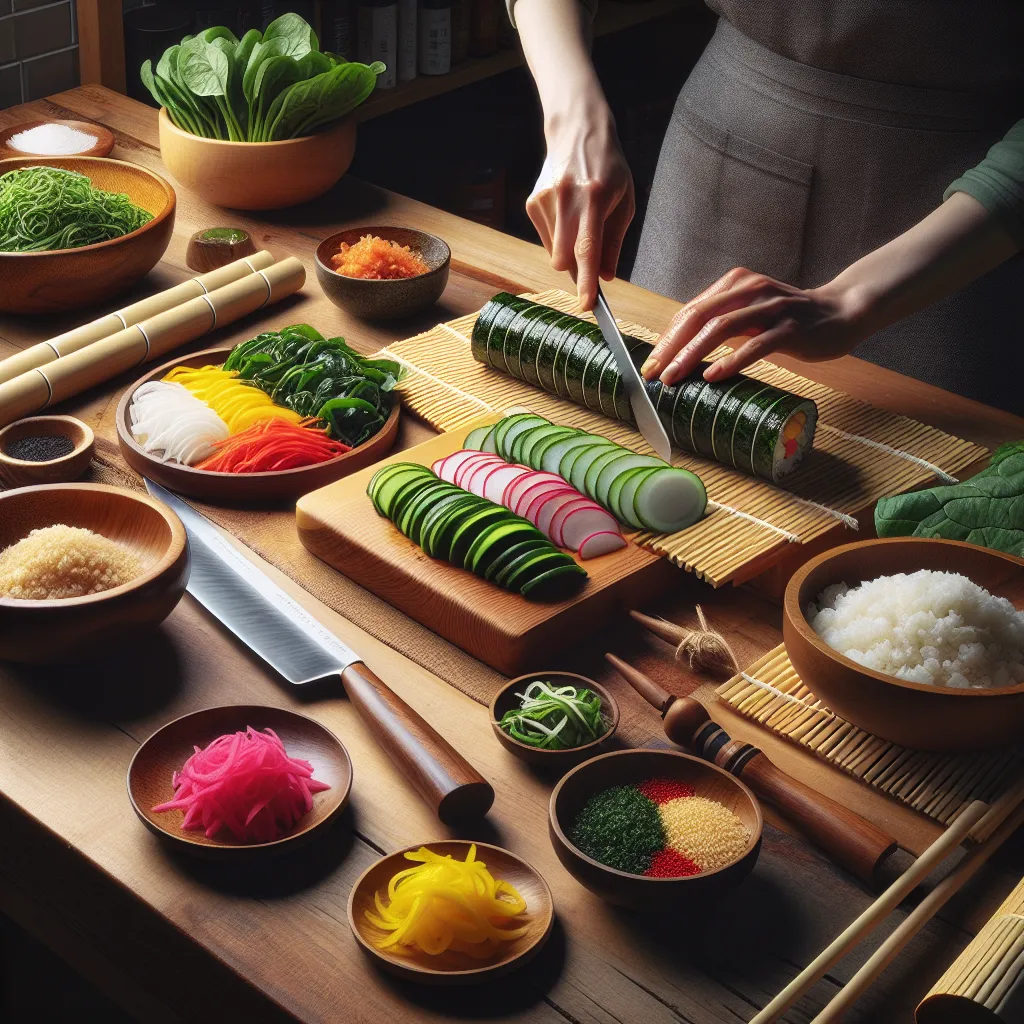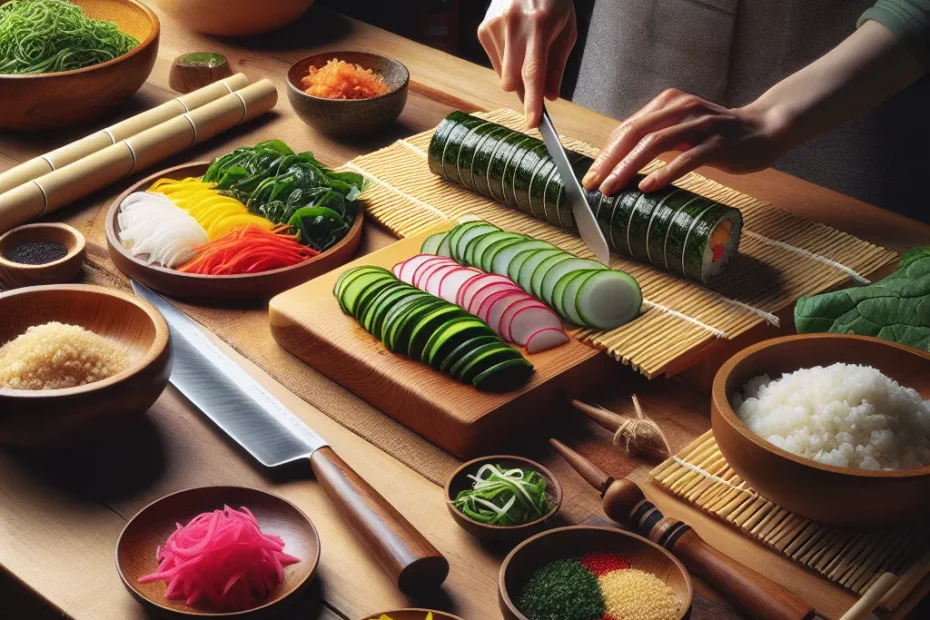Embark on a culinary journey to master the art of making traditional Korean gimbap, a beloved dish that combines flavors, textures, and colors in perfect harmony. As we delve into the world of gimbap-making, we uncover the secrets and techniques that elevate this humble dish to a culinary masterpiece. Join me as we explore the essential ingredients, step-by-step guide, and expert tips to roll the perfect gimbap. Let’s unravel the intricacies of this iconic Korean dish and discover the joy of creating gimbap that not only delights the palate but also celebrates the rich culinary heritage of Korea.

Introduction to Gimbap
Welcome to the world of Gimbap, where the art of making Korean seaweed rice rolls comes to life! Gimbap, also known as Kimbap, is a popular Korean dish made by rolling steamed rice, various ingredients, and seaweed into a delicious, portable snack or meal. This culinary delight not only tantalizes the taste buds but also showcases the meticulous and artistic nature of Korean cuisine.
Gimbap: A Versatile Delight
Gimbap is a versatile dish that can be customized to suit various preferences and dietary needs. From classic fillings like pickled radish, spinach, and carrots to modern twists with ingredients like bulgogi beef or spicy tuna, the possibilities are endless. The balance of flavors and textures in each bite of Gimbap is what makes it a beloved dish both in Korea and around the world.
The Perfect Rice
One of the key elements of Gimbap is the perfect rice. The rice used in Gimbap is seasoned with a mixture of sesame oil, salt, and sometimes vinegar to enhance its flavor. The rice should be sticky enough to hold the ingredients together but not overly mushy. Achieving the right rice texture is crucial in creating a well-balanced Gimbap roll.
Essential Seaweed
Seaweed, known as gim or laver, is another essential component of Gimbap. The roasted seaweed sheets provide a crispy texture and a subtle umami flavor to the rolls. The seaweed also acts as a natural wrapper, holding all the ingredients together while adding a hint of oceanic essence to each bite.
Harmonious Fillings
In addition to rice and seaweed, Gimbap fillings play a vital role in creating a harmonious flavor profile. Common fillings include vegetables like cucumber, burdock root, and egg strips, as well as proteins such as bulgogi beef, ham, and fish cakes. The combination of colors, flavors, and textures in Gimbap fillings ensures a delightful eating experience with every roll.
As you embark on your Gimbap-making journey, remember that practice makes perfect. The art of rolling Gimbap may seem daunting at first, but with time and patience, you will master the technique and create beautiful, delicious rolls that are sure to impress. So gather your ingredients, roll up your sleeves, and let the Gimbap-making adventure begin! 🍣🥢
Essential Ingredients for Gimbap-Making
Embark on a culinary journey to master the art of creating the beloved Korean dish, gimbap. To craft the perfect gimbap, one must first gather the essential ingredients that form the foundation of this delectable seaweed rice roll. Let’s delve into the key components that will elevate your gimbap-making experience to new heights!
Rice:
Rice: The heart and soul of gimbap, rice plays a crucial role in determining the texture and flavor of the final dish. Opt for short-grain white rice, such as sushi rice, known for its sticky consistency that binds the ingredients together harmoniously.
Seaweed Sheets (Gim):
Seaweed Sheets (Gim): Also known as gim, these roasted seaweed sheets provide the quintessential crispiness and umami flavor that define gimbap. Ensure you select high-quality gim to achieve that perfect balance of texture and taste.
Vegetables:
Vegetables: A colorful medley of vegetables adds freshness and crunch to gimbap. Carrots, cucumbers, spinach, and pickled radish are popular choices that bring a vibrant contrast to the rice. Slice them into thin, uniform strips for easy rolling.
Protein:
Protein: From savory bulgogi beef to tender crab sticks, protein options in gimbap are versatile and customizable. Cook your protein of choice with seasonings that complement the overall flavor profile of the dish.
Egg:
Egg: Thinly sliced omelette strips are a common ingredient in gimbap, offering a delicate texture and subtle richness. Season the eggs with a pinch of salt and sugar before cooking to enhance their flavor.
Seasoned Rice Vinegar:
Seasoned Rice Vinegar: To infuse the rice with a tangy and slightly sweet flavor, seasoned rice vinegar is a must-have ingredient. Mix it with a bit of sugar and salt, then gently fold it into the warm rice for a delightful taste sensation.
Sesame Oil and Seeds:
Sesame Oil and Seeds: A drizzle of nutty sesame oil and a sprinkle of toasted sesame seeds add a final touch of aromatic depth to your gimbap. These ingredients elevate the overall taste profile and provide a delightful fragrance.
Mastering the art of gimbap-making requires a meticulous selection of these essential ingredients, each playing a vital role in creating a harmonious blend of flavors and textures. With practice and precision, you’ll soon be rolling up perfect gimbap rolls that delight both the eyes and the taste buds. Happy rolling! 🍣🥢
Step-by-Step Guide to Rolling Perfect Gimbap
Welcome to the art of making perfect gimbap, a beloved Korean dish loved for its delicious taste and beautiful presentation! Gimbap, also known as kimbap, is a popular choice for a quick meal or a tasty snack. It consists of seasoned rice, various fillings, and seaweed, all rolled into a neat cylinder and sliced into bite-sized pieces. Let’s dive into the step-by-step process of creating your own flawless gimbap masterpiece!
Step 1: Prepare the Ingredients
To start, gather your ingredients: sushi rice, roasted seaweed sheets (gim), fillings such as pickled radish, carrots, spinach, and protein like bulgogi or tuna, and sesame oil. Ensure that all ingredients are sliced thinly and ready for assembly.
Step 2: Season the Rice
Cook the sushi rice according to package instructions. Once cooked, mix in a combination of rice vinegar, sugar, and salt to season the rice. The rice should be slightly sticky for easy rolling.
Step 3: Assemble the Fillings
Lay a bamboo sushi rolling mat on a flat surface and place a seaweed sheet on top. Spread a thin layer of seasoned rice evenly over the seaweed, leaving a small border at the top edge. Arrange your fillings in a line across the center of the rice.
Step 4: Roll the Gimbap
Using the bamboo mat as a guide, tightly roll the gimbap away from you, applying gentle pressure to ensure a firm roll. Once rolled, seal the edge by moistening the seaweed border with a bit of water. This will help the gimbap stick together.
Step 5: Slice and Serve
With a sharp knife, slice the rolled gimbap into bite-sized pieces. To prevent the knife from sticking, lightly wet it with water between cuts. Arrange the gimbap on a plate, sprinkle with sesame seeds, and serve with soy sauce or spicy gochujang for dipping.
Step 6: Enjoy Your Perfect Gimbap!
Congratulations, you have successfully rolled your own perfect gimbap! The combination of flavors and textures in each bite is sure to delight your taste buds. Share your creation with friends and family, and savor the satisfaction of mastering the art of gimbap making!
Now that you’ve mastered the step-by-step process of rolling perfect gimbap, feel free to experiment with different fillings and flavors to create your own unique variations. Happy rolling and happy eating! 🌟🍣
Tips and Tricks for Elevating Your Gimbap-making Skills
Are you ready to take your gimbap-making skills to the next level? Let’s dive into some expert tips and tricks that will help you master the art of creating delicious Korean seaweed rice rolls like a pro! 🍣✨
1. Perfect Rice Preparation
Perfect Rice Preparation: The foundation of a great gimbap is perfectly cooked rice. Make sure to wash the rice thoroughly to remove excess starch, and cook it with just the right amount of water for a sticky yet fluffy texture. A rice cooker can be your best friend in this process! 🍚👌
2. Seasoning is Key
Seasoning is Key: Don’t forget to season your rice with a mixture of rice vinegar, sugar, and salt. This not only adds flavor but also helps the rice stick together better when rolling. The balance of sweet, salty, and tangy is what sets a good gimbap apart from a great one! 🍙🔑
3. Fresh and Vibrant Fillings
Fresh and Vibrant Fillings: Use fresh and colorful ingredients to make your gimbap visually appealing and flavorful. From crunchy vegetables like carrots and cucumbers to savory proteins like bulgogi or tuna, the possibilities are endless. Just make sure to cut everything into thin strips for easy rolling! 🥕🥒🥩
4. Master the Rolling Technique
Master the Rolling Technique: Rolling gimbap can be a bit tricky at first, but practice makes perfect! Spread a thin layer of rice on the seaweed, leaving a small border at the top to seal the roll. Use a bamboo mat to help you roll tightly and evenly, applying gentle pressure as you go. Before you know it, you’ll be rolling like a pro! 🍥🔄
5. Slice with Precision
Slice with Precision: To showcase your beautiful gimbap rolls, it’s essential to slice them with precision. A sharp knife dipped in water will help you get clean cuts without squishing the roll. Aim for bite-sized pieces that are as visually appealing as they are delicious! 🍽️🔪
6. Dipping Sauce Delight
Dipping Sauce Delight: Elevate your gimbap experience with a tasty dipping sauce. A classic combination of soy sauce, sesame oil, and a sprinkle of sesame seeds is always a winner. Feel free to customize your sauce with a touch of spicy gochujang or a squeeze of fresh lemon juice for an extra kick! 🌶️🍋
By incorporating these tips and tricks into your gimbap-making routine, you’ll be well on your way to creating stunning and delicious seaweed rice rolls that will impress friends and family alike. Get ready to elevate your gimbap game and enjoy the rewarding experience of mastering this traditional Korean dish! 🌟🇰🇷
In conclusion, mastering the art of making gimbap is not just about creating a delicious dish, but also about embracing Korean culinary culture and tradition. By following the step-by-step guide and incorporating essential ingredients with precision, you can elevate your gimbap-making skills to new heights. Remember, practice makes perfect, so don’t be discouraged by initial challenges. With dedication and attention to detail, you can impress your friends and family with beautifully rolled gimbap that not only tastes amazing but also reflects the true essence of Korean cuisine. Happy rolling!
